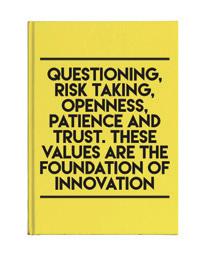
5 minute read
A New Business Model for Cyprus and Beyond
By Nicos G. Sykas, Strategy, Communications and Innovation Consultant
Nations and corporations face multiple, unprecedented challenges in a changing landscape characterized by intensifying competition, fluidity, uncertainty, complexity, interdependencies, volatility, asymmetries and catastrophic risks. You cannot tackle dynamic challenges in 2020 and 2030 with static tools and techniques from 1970 and 1980. Up to 98% of innovations/startups fail. New strategic tools and polyparametric approaches to innovation are needed. The new Innovation Model that I have developed constitutes a step-by-step practical Guide that will helps both the public sector and businesses generate more and better innovation. It is an end-to-end innovation process blueprint, which includes, amongst others, the following creative, strategic, commercialization and sustainability evaluation criteria and success factors:
1. Good product; quality. Most startups fail because they have the wrong product. 2. Value-creating insight. Does it provide a real solution to a real problem, solve a painful problem, meet a need or create customer value? Is there a gap in the market? 3. Supremely consumer-centric: Solve the pain points or facilitate moments of joy in people’s lives. Treat consumers as coproducers of value, encouraging a two-way dialogue. Enhance human experience. 4. Creative excellence: Τhe idea must be original, unique, authentic, singular and impactful. 5. The concept must be distinctive, simple and instantly understandable, contextually relevant and engaging/likeable. 6. Ease of implementation: The concept must be realizable. 7. Elasticity, adaptability, agility, practicality, efficiency. 8. Customer metrics: The closer you can define your target market and customer profiles, the better you can integrate this data into your sales forecast. 9. Test and validate the ideas with customers. 10. Iterate your way to product/market fit, constantly developing your product and business model to ensure the widest and deepest possible growth in terms of users. 11. Timing: Customer readiness. 12. Differentiated branding and positioning, product/market fit and successful advertising during both launch and growth phases help startups and spinoffs bridge the ‘Valley of Death’. 13. Strategic planning and risk management. Eliminate biases and prediction errors across the different stages of the innovation process in order to improve judgment and decision making. 14. Validate the business plan – realistic and well-documented assumptions; a complete value chain model. 15. Does it provide a sustainable competitive advantage? 16. Value proposition vs competition; danger of being outcompeted. 17. Innovation is inherently uncertain. In a startup we need to increase exploration, randomness and variability.
18. Generate antifragile innovations
(resilient, future-proof, get better with time). The design – the structure – of an innovation should be such that it exploits and benefits from volatility, variability, randomness, uncertainty and time by maximizing exposure and benefit from positive (favourable) asymmetries and minimizing exposure and harm from negative (unfavourable) asymmetries – more upside than downside from volatility and randomness. 19. Black Swans: The field of innovation is concerned with finding ‘Black Swans’, rare events that capture significant returns. A ‘Black Swan’ is a rare, unpredictable event that has a major effect (large magnitude and consequence) – it carries an extreme impact (positive asymmetries or negative asymmetries). The ‘Black Swan’ and ‘Antifragility’
theories were developed by Professor Nassim Nicholas Taleb, the world’s leading authority on Risk Management.
20. Increase your innovation success rate
by ensuring that your business model links market needs with emerging and exponential technologies. This is where positive ‘Black Swans’ can usually be spotted – Business Models that create all three forms of value: Cost Value, Experience Value and Platform Value (Uber, Airbnb, etc.). 21. Strong team. Grow the human re-

sources and decision-making capacity of your firm: Ensure that your talent and governance structures are continually evolving to meet growth requirements. 22. Securing finance – make sure you have the financial resources to grow, either using organic cash flow or external financing; Business Angels, Venture Capital, Crowdfunding, etc. 23. Startups/Spinoffs: Avoid capitalheavy investments (like property); invest in market share and market growth. 24. Business-friendly ecosystem: culture of creativity and innovation. 25. Innovative Governance. Regulatory framework; the role of standardization and standards in promoting innovation. 26. Entrepreneurial Infrastructure – Incubators, Accelerators, Innovation Hubs, Co-working Spaces. 27. Expected results and impacts; direct and indirect, short and long term impact; have potential for longevity. 28. The focus should be on how the Business Model can synergistically produce economic, social and environmental value. 29. Added value – local, regional, European impact. 30. Scalability with a global outlook. 31. Transferability into other policy areas, disciplines and purposes; the use of Metaphors and Analogies as creative mechanisms for transforming and transferring innovative ideas from one context and situation to another. Analogies highlight non-obvious similarities between two things that appear to be dissimilar, and individuals solve novel problems by making analogous connections to other problems they have faced in the past and by adopting and adapting their existing solutions to fit the new problem. 32. Five core values of innovation: Questioning, risk taking, openness, patience and trust. These values are the foundation of innovation. As group, they determine the capacity for change of an individual, organization or nation.
The New Innovation Paradigm:
a) Combines ideas, concepts, elements, symbols, features or capabilities from the four basic types of innovation: product, process, organizational and marketing. This interactive process creates novel connections, multiple perspectives and diverse combinatorial possibilities. By overseeing the nature of the interconnections amongst the four innovation types, we can zoom into the interface, focus on different aspects, iterate through all possibilities, discern alternatives and increase the probability for breakthrough innovation. b) Fosters innovation at the interface between ‘big data’ analytics and intuition. Leverages artificial intelligence to enhance human creativity; data driven insights. Identifying and acting on insights faster. c) Accelerates Speed to Market. d) Promotes a co-creation approach, bringing together all key stakeholders (central government, local authorities, academia, business, suppliers, customers and civil society) disciplines and units (Engineering, Operations Processes, Information and Communication Technology, Organizational Psychology, Creative Industries, Marketing, Branding). Such a multidisciplinary approach promotes collaboration and interaction and enhances creativity and innovation (cross-fertilization of ideas and disruption of ‘silothinking’). The intersection of different fields, domains, disciplines and networks creates new opportunities for growth and innovation. e) Constitutes a cross-cutting tool that can be applied in practically every sector/discipline and at all levels and scales: public sector innovation, positive reform, social innovation, FinTech and RegTech innovation, cost innovation, education, smart cities, startups/spinoffs, small and medium-sized businesses, multinational corporations, risk management, cyclical economy, nation branding, economic diplomacy, political campaigns etc.
The dynamic Integrated Innovation System briefly described above can:
1. Align all key stakeholders for faster innovation. 2. Bridge the gap between innovation strategy and execution. 3. Catalyze implementation of a) Cyprus’ National Strategic Framework for Research and Innovation 2019–2023 and b) Horizon Europe 2021–2027, the new EU programme for research and innovation (facilitating cross-disciplinary, cross-sector and cross-actor innovation to achieve multiple, bottom-up solutions).
This versatile innovation tool can be:
a) Characterized as the Swiss Army Knife for creating a New Business Model for Cyprus and sharpening Europe’s competitive edge and b) Applied with the help of an analytical Innovation Toolkit that I have developed.








